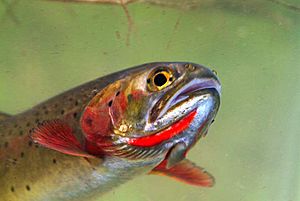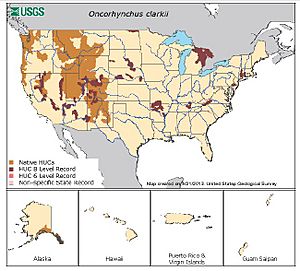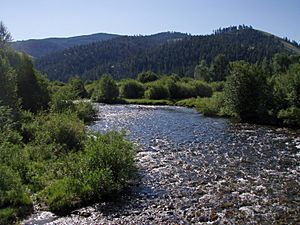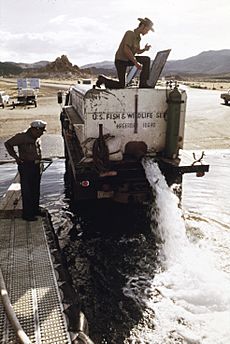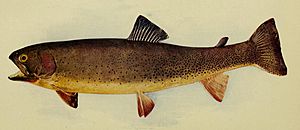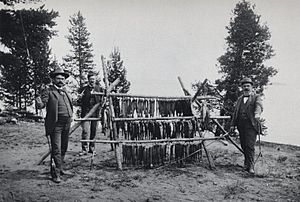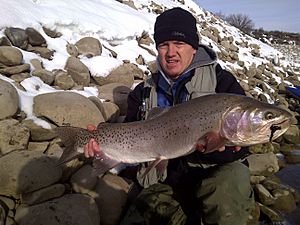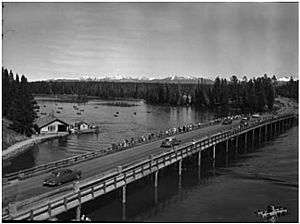Cutthroat trout facts for kids
Quick facts for kids Cutthroat trout |
|
|---|---|
 |
|
| Coastal cutthroat trout, Oncorhynchus clarkii clarkii, the type subspecies | |
| Scientific classification | |
| Genus: |
Oncorhynchus
|
| Species: |
clarkii
|
| Subspecies | |
|
Subspecies
Oncorhynchus clarkii clarkii
O. c. alvordensis† |
|
| Synonyms | |
|
previous scientific names
Salmo clarkii (Richardson, 1836)
Fario clarkii (Richardson, 1836) Parasalmo clarkii (Richardson, 1836) Salmo clarkii clarkii (Richardson, 1836) Salmo clarki (Richardson, 1836) Salmo clarki clarki (Richardson, 1836) Fario stellatus (Girard, 1856) Salmo stellatus (Girard, 1856) Salar lewisi (Girard, 1856) Salmo lewisi (Girard, 1856) Salmo clarki lewisi (Girard, 1856) Salmo clarkii lewisi (Girard, 1856) Salmo brevicauda (Suckley, 1861) Salmo pleuriticus (Cope, 1872) Salmo purpuratus bouvieri (Jordan & Gilbert, 1883) Salmo clarkii alpestris (Dymond, 1931) Salmo mykiss (non Walbaum, 1792) Salmo purpuratus (non Pallas, 1814) |
|
The cutthroat trout (Oncorhynchus clarkii) is a type of fish. It belongs to the family called Salmonidae. These fish live in cold waters in North America. You can find them in rivers that flow into the Pacific Ocean, in the Rocky Mountains, and in the Great Basin.
Cutthroat trout are part of the Oncorhynchus group. This group also includes the well-known rainbow trout. Many people enjoy fishing for cutthroat trout, especially with fly fishing. The name "cutthroat" comes from the bright red color under their lower jaw. The scientific name clarkii honors William Clark, a famous explorer from the Lewis and Clark Expedition.
These trout usually live and lay their eggs in clear, cold, shallow rivers with rocky bottoms. They also live in clear, cold lakes. They are native to the natural streams that feed into larger rivers. Cutthroat trout lay eggs in the spring. They can sometimes breed with rainbow trout, creating a mix called "cutbows." Some coastal cutthroat trout can even swim between fresh water and the ocean.
Sadly, some types of cutthroat trout are now threatened. This is because their homes are being destroyed. Also, new fish species have been brought into their areas. Two types of cutthroat trout are now extinct. Fish farms help raise cutthroat trout to bring their numbers back up. They also stock lakes for fishing. The cutthroat trout is the official state fish for seven western U.S. states.
Contents
What is a Cutthroat Trout?
Cutthroat trout come in many sizes and colors. Their backs can be golden, gray, or green. You can usually tell them apart from rainbow trout by looking for small teeth at the base of their tongue. Also, their upper jaw extends past their eye.
Most cutthroat trout have red, pink, or orange marks under their lower jaw. These marks look like a "cut" throat, which is how they got their name. A writer named Charles Hallock first used this name in 1884. But remember, some rainbow trout can also have similar red marks.
How Big Do They Get?
Adult cutthroat trout can be from 6 to 40 inches (15 to 100 cm) long. Their size depends on where they live and how much food they can find. Coastal cutthroat trout that swim to the sea often weigh 2 to 5 pounds (0.9 to 2.3 kg).
Trout that stay in streams are much smaller, weighing only about 0.4 to 3.2 ounces (11 to 91 grams). But trout living in lakes can grow very large. Some have reached 12 to 17 pounds (5.4 to 7.7 kg) in perfect conditions. The biggest type is the Lahontan cutthroat trout. The world record for a cutthroat trout is a Lahontan. It was 39 inches (99 cm) long and weighed 41 pounds (18.6 kg)!
Their Life Cycle
Cutthroat trout usually live and lay eggs in clear, shallow rivers with gravel bottoms. They need water with lots of oxygen. They lay their eggs in the spring. This can be as early as February in coastal rivers or as late as July in high mountain streams. Spawning starts when the water temperature is about 43 to 46°F (6 to 8°C).
The female trout digs a nest, called a redd, in the river gravel. She lays between 200 and 4,400 eggs, depending on her size. A male trout then fertilizes the eggs. The eggs hatch into tiny fish called alevins in about a month. These baby fish stay in the gravel for two weeks, feeding on their yolk sac. After that, they emerge and start eating tiny water creatures. Young cutthroat trout usually become adults in three to five years.
Cutthroat trout can breed with rainbow trout. This creates a fertile mix called "cutbows." These hybrids often look like cutthroat trout, keeping the red throat mark. It can be hard to tell them apart from pure cutthroat or rainbow trout.
Where Do Cutthroat Trout Live?
Cutthroat trout are native to western North America. Over time, they have developed into 14 different types, called subspecies. Each subspecies lives in a specific area. You can find them along the Pacific Northwest coast from Alaska to northern California. They also live in the Cascade Range, the Great Basin, and throughout the Rocky Mountains.
Some coastal cutthroat trout swim to the ocean for a few months to feed. Then they return to fresh water to eat insects and lay eggs. Cutthroat trout have the second-largest natural range of any North American trout. The lake trout has the largest range. Sadly, the homes of some subspecies, like the westslope cutthroat trout, have shrunk a lot. This is due to habitat loss and new species being introduced.
Even though they are Pacific trout, three subspecies live east of the Continental Divide. This means their waters flow towards the Atlantic Ocean. Scientists believe these trout crossed the divide millions of years ago. This happened when climate and land changes allowed them to move between river systems.
Cutthroat trout have also been moved to new waters outside their natural range. For example, some were put into lakes in Yellowstone National Park. They were also introduced to the Great Lakes in the 1890s, but they never formed wild populations there.
Their Home and Food
Cutthroat trout need cold, clear rivers with gravel bottoms. They also like cool, moderately deep lakes. Healthy plants along the riverbanks are important. They help keep the water clean. Beaver ponds can also offer safe places for trout during dry times or winter. Most cutthroat trout stay in fresh water their whole lives.
Cutthroat trout eat whatever they can find. In streams, they mostly eat water insects like caddisflies, stoneflies, and mayflies. They also eat land insects like ants and grasshoppers that fall into the water. As they grow, they eat more small fish and fish eggs. In saltwater areas, coastal cutthroat trout eat small fish like sculpins and herring. They also eat shrimp and squid.
Raising Cutthroat Trout
Many types of cutthroat trout are raised in fish farms, called hatcheries. These hatcheries help put fish back into rivers and lakes. In the early 1900s, hatcheries in Yellowstone National Park raised many Yellowstone cutthroat trout. They also sent millions of trout eggs to other hatcheries across the U.S.
Today, hatcheries like the Lahontan National Fish Hatchery work to bring back Lahontan cutthroat trout. They raise hundreds of thousands of young trout each year. Other hatcheries, like Jackson National Fish Hatchery and Leadville National Fish Hatchery, also raise different cutthroat trout subspecies to support fishing.
Dangers to Cutthroat Trout
The natural homes of cutthroat trout have shrunk. This is due to too much fishing, cities growing, and damage from mining and logging. Their numbers have also dropped because of other fish species that were brought in. These include brook trout, brown trout, and rainbow trout. These new fish compete with cutthroat trout for food and space.
The biggest danger to many cutthroat trout types is breeding with rainbow trout. This creates "cutbow" hybrids. These hybrids are not pure cutthroat trout. Also, putting one type of cutthroat trout into an area where another type lives can cause problems. They might breed, making the original type less pure.
Yellowstone Trout Decline
The number of Yellowstone cutthroat trout in Yellowstone Lake dropped a lot in the 1960s. This was because too many fish were caught by anglers. Also, too many eggs were taken by hatcheries. To help, park managers started "catch and release" fishing. This meant anglers had to put the fish back. They also stopped hatchery operations in the park. This helped the trout recover.
But in 1994, park officials found lake trout in Yellowstone Lake. Lake trout are not native to this area. They eat cutthroat trout. By 2000, the cutthroat trout population was very low. However, park staff have worked hard to remove over a million lake trout since 1996. They hope this will help the cutthroat trout numbers go back up.
Fishing for Cutthroat Trout
Cutthroat trout are very popular for fishing, especially for people who enjoy fly fishing. They are a regulated game fish in every state and province where they live. From the famous Yellowstone fishery to the unique Lahontan trout in Pyramid Lake, cutthroat trout are a favorite catch. The world record for any type of fishing tackle is a 41-pound (18.6 kg) fish caught in Pyramid Lake in 1925. Because they eat insects, they are perfect for fly anglers.
Sea-Run Fishing
Along the Pacific Coast, from Alaska to California, people fish for coastal cutthroat trout. These fish can live in the sea, in streams, or in lakes. Puget Sound in Washington is a great place to fish for sea-run cutthroat trout. Fly anglers look for them along beaches and river mouths all year. In larger rivers, anglers use boats to find trout along the wooded shorelines.
Yellowstone Fishing History
Yellowstone National Park was created in 1872. By the 1890s, fishing for Yellowstone cutthroat trout was very popular. People came from all over to fish in the Yellowstone River and Yellowstone Lake.
In 1902, the first "Fishing Bridge" was built across the outlet of Yellowstone Lake. This bridge was rebuilt several times to make room for cars and anglers. By the 1950s and 1960s, fishing at the bridge was so popular that too many fish were caught. Because of this, fishing from Fishing Bridge was stopped in 1973.
Pyramid Lake Fishing
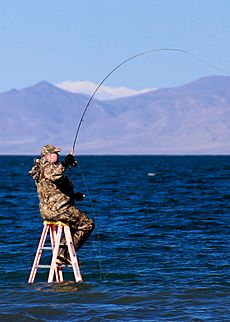
The Lahontan cutthroat trout in Pyramid Lake was almost wiped out between the 1920s and 1940s. This was due to too much fishing, new species, and loss of places to lay eggs. In the 1970s, Pyramid Lake was restocked with Lahontan cutthroat trout from other lakes. However, these were not the huge fish that used to live there.
Later, in the late 1970s, scientists found a pure group of the original Pyramid Lake trout. They were in a small stream on the Nevada-Utah border. In 1995, the U.S. Fish and Wildlife Service began raising these fish. By 2006, these special Lahontan cutthroat trout were put back into Pyramid Lake.
Pyramid Lake has shallow edges, so anglers often use ladders to stand in the water. This lets them cast their lines to the trout. It is now known as a "world-class" fishery. Anglers often catch cutthroat trout weighing over 10 pounds (4.5 kg) there.
A State Symbol
The cutthroat trout is the official state fish of Idaho, Montana, and Wyoming. Specific types of cutthroat trout are also state fish for other states:
- Idaho, Montana, and Wyoming – Cutthroat trout (O. clarki)
- Colorado – Greenback cutthroat trout (O. c. stomias)
- Nevada – Lahontan cutthroat trout (O. c. henshawi)
- New Mexico – Rio Grande cutthroat trout (O. c. virginalis)
- Utah – Bonneville cutthroat trout (O. c. utah)
Images for kids
See also
 In Spanish: Trucha degollada para niños
In Spanish: Trucha degollada para niños


